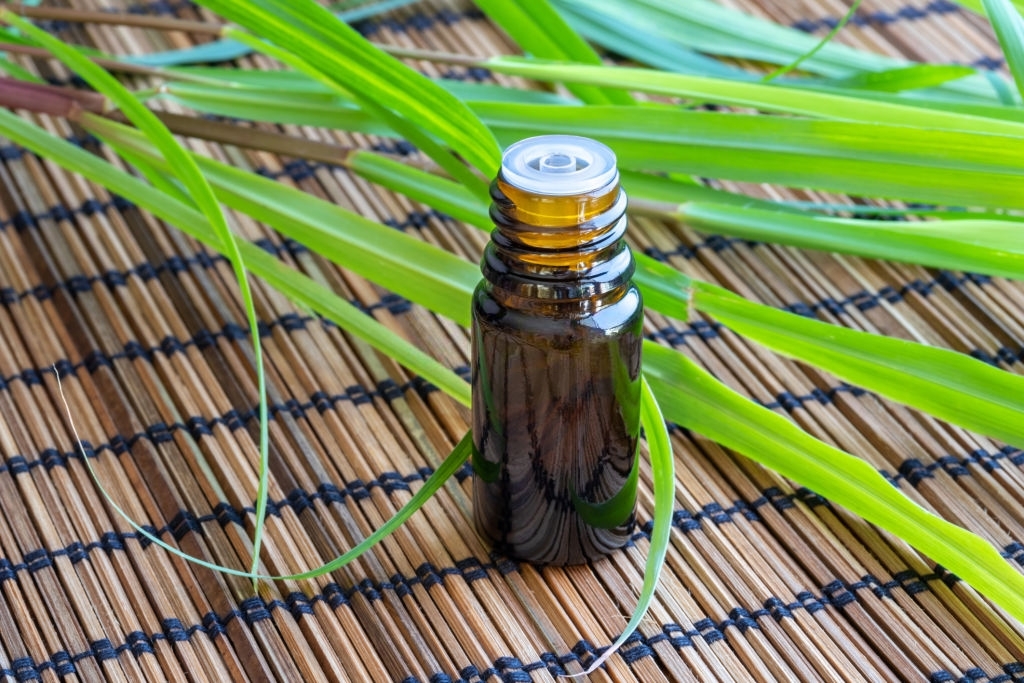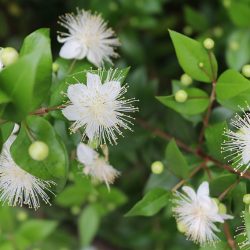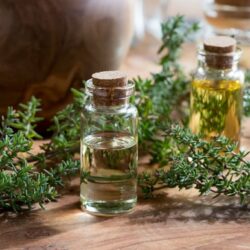Ceylon citronella oil is a natural product that has been used for centuries for its medicinal and aromatic properties. It is known for its mosquito-repellent properties and its lemon balm-like fragrance. Its use dates back to the 17th century, when the military surgeon Nicolas Grimm experimented with it as an antiseptic. Ceylon citronella essential oil has a wide range of applications in fields such as traditional medicine, aromatherapy, cooking and cosmetics.
In this article, we’ll explore the different properties of Ceylon citronella essential oil, as well as its uses and precautions for use. We will also look at the history of the use of Ceylon citronella essential oil and the recent scientific discoveries that have highlighted its benefits for health and well-being.
Ceylon citronella, whose botanical name is Cymbopogon nardus (L.), belongs to the Poaceae family (= Gramineae). The producing organ is the whole plant in flower.
A little history
The origins
Cymbopogon nardus is native to the tropical regions of eastern and southern Africa (Sudan, Zaire, Kenya, Burundi, Rwanda, Uganda, Botswana, Mozambique, Swaziland, Lesotho, South Africa, Madagascar), the Indian subcontinent (India, Bhutan, Bangladesh, Sri Lanka, Seychelles) and South-East Asia (Burma, Laos, Vietnam). There are several varieties of lemongrass, and like all the plants in the Cymbopogon genus (lemongrass, palmarosa, Madagascar lemongrass, or myrcene lemongrass, with slightly different properties and fragrances), lemongrass is a large perennial herb found in tropical countries, growing in clusters of long, narrow leaves up to 1 m high.
All lemongrass varieties are Cymbopogon, a family of herbaceous plants that give off a warm, lemony aroma. One of the most widespread in Madagascar is the citronella known as “Verveine des Indes” (Cymbopogon citratus), which has a calming and sleep-inducing effect and whose essential oil is used in preparations to combat cellulite. Another closely related plant is Lemon Grass (Cymbopogon flexuosus), which produces a very similar essential oil.
Another citronella is Ceylon citronella (Cymbopogon nardus), which has a repellent effect on mosquitoes. All three plants are found in the Moramanga region. A little further afield, and particularly in the Ambanja region (on the north-west coast of Madagascar), we find Palmarosa (Cymbopogon martinii).
Lemongrass belongs to the Poaceae (grass) family, and is shaped like a tuft of long, narrow leaves with rough, sharp edges, reaching up to thirty centimetres in height. It is native to tropical regions and grows particularly in Sri Lanka. Citronella repels insects, particularly mosquitoes.
Nowadays
In the 1900s, citronella was mainly grown in Ceylon and India, but it was also cultivated in Hong Kong, Brazil, East Africa and the West Indies. By 1980, lemongrass production had spread to Ghana and Bolivia. Cultivation of this plant is favoured in hot and developing countries because it is inexpensive and provides additional income for farmers.
Its essence has long been used to repel mosquitoes, and its fragrance is similar to that of lemon balm, whose essential oil is much more expensive. Its use dates back to the 17th century, when the military surgeon Nicolas Grimm experimented with it as an antiseptic.
These great aromatic herbs were well known to the Greeks (Dioscorides, 1st century) and the Romans. Pliny describes citronella for its olfactory, disinfectant and insect-repellent qualities, particularly against moths. Ceylon citronella has been used as an insect repellent since the end of the Second World War.
These great aromatic herbs were known to the Greeks(Dioscorides, 1st century) and Romans. Pliny describes citronella for its olfactory, disinfectant and insect-repellent qualities, particularly against moths. It was probably not Ceylon citronella, but a related species, Indian verbena(Cymbopogon citratus), or Indian spikenard.
Ceylon citronella has been used as an insect repellent since the end of the Second World War. In Ceylon, it is used as an infusion and as a flavouring agent. It is also used in perfumes and soaps. Java citronella is sometimes considered to be a variety of Ceylon citronella. Ceylon citronella essential oil is described as fresh, oily and camphorated, while Java citronella essential oil is described as light, sweet, flowery and rosy.
What are the pharmacological properties of Ceylon citronella whole plant oil?
Ceylon citronella whole plant oil in flower has many interesting pharmacological properties. It is used in traditional medicine to treat a variety of ailments, such as muscle and joint pain, headaches, digestive disorders and respiratory problems. It also has antiseptic, anti-inflammatory and antifungal properties. In this article, we will explore in more detail the different pharmacological properties of Ceylon citronella whole plant oil.
Antimicrobial properties:
One of the most remarkable features of Ceylon Citronella essential oil is its powerful antimicrobial property. This ability is mainly due to the presence of compounds such as geranial, neral and geraniol, which give it notable antibacterial and antiviral effects.
Studies have shown that these components are particularly effective against specific pathogens. For example, they show significant antibacterial and antiviral activity against the herpes virus, a common pathogen that causes skin and mucous membrane infections. In addition, they have antifungal properties, effective against candidiasis – infections caused by yeasts of the Candida genus, which are often difficult to treat. These compounds are also active against fungal infections of the scalp, particularly those caused by Trychosporon ovoides, as well as various nosocomial infections linked to Candida.
The citronellol and citronellals contained in Ceylon Citronella oil also play a key role in its antimicrobial activity. These components reinforce the oil’s antibacterial effect, offering additional protection against a wide range of pathogenic bacteria.
In addition, Ceylon Citronella essential oil is recognised for its anti-infective potential, particularly in the treatment of urogenital and skin disorders. This suggests that it could be used effectively in the prevention and treatment of infections in these areas, offering a natural alternative to traditional antibiotic treatments.
These antimicrobial properties make Ceylon Citronella oil an ingredient of choice in a variety of applications, including skin care products, antiseptic treatments and the formulation of natural disinfectant products. Its ability to combat a wide range of pathogenic micro-organisms underlines its importance as a natural component in the field of health and well-being.
Anti-inflammatory properties :
Citronellal reduces inflammation mediators, inhibits PGE2 prostaglandins and has antioxidant action. Geranial and neral have an anti-inflammatory action without inducing stomach ulcers.
Ceylon citronella stimulates the pituitary-cortical-adrenal axis and is useful in the treatment of prolonged inflammatory conditions, particularly in rheumatology.
Analgesic properties :
One of the most remarkable aspects of Ceylon Citronella essential oil is its ability to act as an effective analgesic. This property, mainly attributed to the presence of citronellal in the oil, gives it notable analgesic properties. When administered orally, citronellal has an action similar to that of opiates, significantly relieving pain.
Citronellal’s mechanism of action as an analgesic is intriguing. Studies have shown that administration of naloxone, a known opioid receptor blocker, interferes with citronellal’s analgesic effect. This phenomenon not only confirms the effectiveness of Ceylon citronella essential oil as an analgesic, but also highlights its interaction with the body’s opioid system.
This specific interaction illustrates how Ceylon citronella essential oil, and in particular the citronellal it contains, can play a major role in pain relief. Citronellal’s ability to mimic the effects of opiates, without the drawbacks associated with these substances, makes it a promising candidate for future therapeutic applications, particularly in the treatment of chronic or acute pain.
The potential of Ceylon citronella oil as an analgesic opens up interesting avenues for medical research and the development of alternative treatments. With its relatively high safety profile and natural properties, this oil could prove to be a gentle and effective solution for those looking for natural ways to manage pain.
Insect repellent properties:
Geraniol combined with citronellol is an active repellent for two to four hours as well as an insecticide against mites and lice. Citronellal destroys the larvae of the mosquito that carries dengue fever(Aedes aegypti). Neral and geranial are also repellents.
A miticide, but less so than spearmint, citronella also repels wasps.
Antispasmodic property:
One of the most interesting pharmacological properties of Ceylon Citronella whole plant flower essential oil is its antispasmodic effect on muscles. This property is due to the presence of chemical compounds such as citronellol and geraniol. Use Ceylon lemongrass essential oil to relieve muscle cramps and contractures. Apply it topically with a carrier oil, such as coconut oil or sweet almond oil, to the affected area.
In aromatherapy, Ceylon citronella essential oil is also used to exert an overall effect on the whole body. Using a diffuser, the essential oil can be diffused into the air to help relax muscles and relieve tension. Please note that Ceylon citronella essential oil needs to be diluted before being applied to the skin. Take special precautions when using it on children or pregnant women.
Other properties:
- Anticonvulsant through activity on GABAergic neurotransmission
- Immunostimulant
- Decongestant for the pelvic and respiratory regions
- General tonic and stimulant (positivising, as it ionises positively)
- Expectorant and balsamic
- Lymphotonic
Are there any precautions to be taken when using Ceylon citronella essential oil?
- Ceylon citronella essential oil is potentially allergenic, as it increases the release of histamine
- Not recommended for pregnant women under 3 months of age
- Contraindicated in children under 8 years of age
- Enzyme inhibitor, risk of drug interactions(geraniol) – Ask your pharmacist for advice
- Not to be used undiluted (skin revulsant) – Dilution required
- Caution in cases of renal failure per os as nephrotoxic
- Avoid in combination with cortisone, risk of drug interaction
- Do not use over a prolonged period, as there is a risk of resting the pituitary-adrenal axis and suffering acute adrenal insufficiency if you stop taking the essential oil
- Avoid applying the essential oil in the evening (or before any period of rest)
- Not recommended for people suffering from osteoporosis, due to the inherent risk of decalcification
Medical literature and clinical trials:
- Delespaul, Quitterie & Billerbeck, V & Roques, Christine & Michel, Georges & Marquier-Viñuales, Cécile & Bessière, Jean-Marie (2000). The Antifungal Activity of Essential Oils as Determined by Different Screening Methods. Journal of Essential Oil Research
- Leite BL, Bonfim RR, Antoniolli AR, Thomazzi SM, Araújo AA, Blank AF, Estevam CS, Cambui EV, Bonjardim LR, Albuquerque Júnior RL, Quintans-Júnior LJ. Assessment of antinociceptive, anti-inflammatory and antioxidant properties of Cymbopogon winterianus leaf essential oil. Pharm Biol. 2010
- Silva MR, Ximenes RM, da Costa JG, Leal LK, de Lopes AA, Viana GS. Comparative anticonvulsant activities of the essential oils (EOs) from Cymbopogon winterianus Jowitt and Cymbopogon citratus (DC) Stapf. in mice. Naunyn Schmiedebergs Arch Pharmacol. 2010
- Amer A, Mehlhorn H. Repellency effect of forty-one essential oils against Aedes, Anopheles, and Culex mosquitoes. Parasitol Res. 2006
- Zhang QH, Schneidmiller RG, Hoover DR. Essential oils and their compositions as spatial repellents for pestiferous social wasps. Pest Manag Sci. 2013





